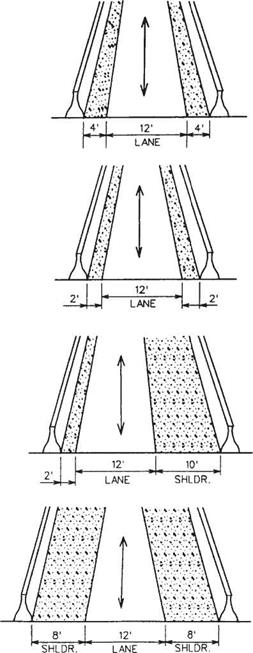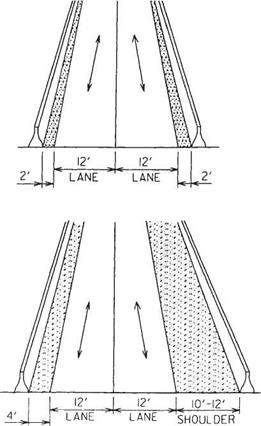Freeway Design Considerations
There are three types of HOV lane patterns—separated lanes, concurrent flow lanes, and contraflow lanes. Regardless of which pattern is chosen, consideration should be given to traffic operations at interchanges and on-ramps, pedestrian access to on-line stations, the availability of parking areas at or near the stations, and the possible use of HOV lanes during freeway maintenance of traffic operations. Design speeds should generally be the same as for the mainline facility. Recommended lane and shoulder widths can be seen in the next group of referenced figures (Figs. 2.61 through 2.66).
A separated HOV lane may be located in the median or on the outside of the general lanes, or follow an independent alignment. See Figs. 2.61, 2.62, and 2.63 for examples of cross sections. Figures 2.64 and 2.65 show two examples of how separated HOV lanes tie in with the general main lanes of travel. Figure 2.66 shows sample signing and pavement marking used in connection with HOV lanes. Note the diamond symbol that signifies an HOV lane.
Concurrent flow lanes are located adjacent to traffic lanes and are not physically separated from them. Figures 2.67 and 2.68 are examples of typical sections for concurrent HOV lanes.
|
FIGURE 2.61 Cross sections for high-occupancy-vehicle single lane on separated roadway; one-way or reversible. Conversion: 1 ft = 0.305 m. (From Guide for the Design of High Occupancy Vehicle Facilities, American Association of State Highway and Transportation Officials, Washington, D. C., 1992, with permission) |
|
FIGURE 2.62 Cross sections for high-occupancy-vehicle double lanes on separated roadway; one-way or reversible. Conversion: 1 ft = 0.305 m. (From Guide for the Design of High Occupancy Vehicle Facilities, American Association of State Highway and Transportation Officials, Washington, D. C., 1992, with permission) |
Contraflow lanes provide an exclusive lane for HOVs traveling in the peak direction by removing a lane from service in the off-peak direction. These may be used in areas where traffic volumes in the off-peak directions are such that the level of service is not seriously affected. Some kind of buffer zone or device is strongly recommended for obvious safety considerations. Figure 2.69 provides examples of cross sections for contraflow HOV lanes.








Leave a reply